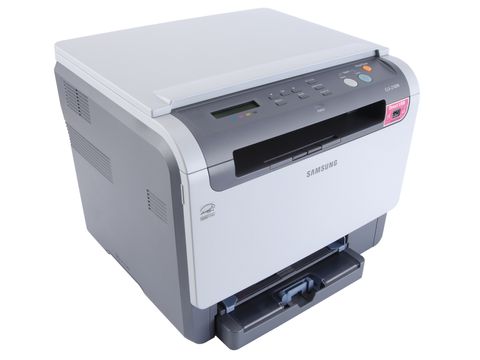TechRadar Verdict
Convenient, but print quality could be better
Pros
- +
Small and lightweight
Standalone photocopying
Cons
- -
Mixed printing results
Why you can trust TechRadar
Colour inkjet multi-functional devices aren't quite ten-a-penny, but the starting price is well under £100 and there are dozens of models to choose from. By comparison, perhaps due to the premium on desktop real estate, colour laser printers with built-in scanners are scarce.
A notable newcomer is the Samsung CLX-2160N, which is smaller and lighter in weight than most standalone desktop colour laser printers - even more remarkable when you consider that it has a built-in 1200 x 600dpi scanner for standalone mono or colour photocopying or scanning.
Another bonus is that Ethernet connectivity comes as standard kit in addition to a regular USB 2 connection, making the printer a bargain with its £295 price tag.
Under the hood, the CLX's print engine is basically the same as that used in the Samsung CLP-300N printer. This is both good news and bad news.
On the plus side, a set of cartridges costs a fairly frugal £124, which is about a third of the price of some competing models.
You don't get something for nothing, however, because the black toner cartridge only lasts for 2,000 pages and the cyan, magenta and yellow cartridges are only good for about 1,000 pages, based on the usual five per cent coverage per colour.
This means that the consumables cost is fairly high, at about 1.8p per mono page and 8.9p for colour, making the Samsung ideal for reasonably low-volume usage only.
The CLX's print quality is a bit of a mixed feast. Despite a high 2,400dpi enhanced print resolution, text appeared less sharp in our tests, in comparison with most similarly priced colour lasers.
For graphics and photos, colour reproduction is a little pale and insipid, though one nice spin-off is that you gain extra definition in lowlights (darker areas) of photos.
Again, sharpness can be poor but banding (light stripes across the page) is minimal, the Samsung performing better in this respect than the small Dell 1320c colour laser that we reviewed last month.
In our tests, the CLX proved quick for mono printing, with a first page print time of just 13 seconds, making it one of the fastest in its class. However, because of its four-pass colour printing technology, the first page time for full colour documents proved slow, at about 28 seconds.
Top-quality photo output took about 45 seconds for an A4 print - the same length of time required for a normal quality colour photocopy. Colour speeds for multi-page printing easily lived up to Samsung's 4ppm claims.
More than just another printer, the Samsung's main attraction is its ability to do standalone photocopying, and to support this there's a refreshingly intuitive user interface built around 11 control buttons and a two-line alpha-numeric LCD display.
Meanwhile, back with PC-based operations, the printer driver is equally simple, while software additions include ReadIris Pro 10 for OCR (Optical Character Recognition) work, a generous inclusion considering the Samsung's price.
In summary, the CLX's print quality certainly isn't top of the class, but it's a good all-rounder and easy to live with.
Tech.co.uk was the former name of TechRadar.com. Its staff were at the forefront of the digital publishing revolution, and spearheaded the move to bring consumer technology journalism to its natural home – online. Many of the current TechRadar staff started life a Tech.co.uk staff writer, covering everything from the emerging smartphone market to the evolving market of personal computers. Think of it as the building blocks of the TechRadar you love today.

